I am creating a new SSIS 2008 ETL report that will read data from a SQL Server and append it to an ACCESS 2010 database table. How can I append records to an existing access table when there is an identity column in the Access table?
My current solution has an OLE DB source with SQL that reads the data. It connects to a data conversion task and then that connects to an OLE DB destination task. The identity field in the access table is named "Id" and it is an autonumber field.
I am able to insert the values using an OLE DB destination when the Access table is empty. The problem has to do with the identity field and when there are already records in the table.
So, the problem is that my Id column always starts at 1, which means I get an error as the engine thinks I am trying to insert a duplicate key.
I created a SQL Task that reads the max ID from the table and stores it into a variable, but now I am stuck trying to figure out how to use this value in my data flow export process.
Will someone please show me how to insert data into an Access DB when there are already records in the table?
Edited for clarity. I have added the SQL that I use to obtain the desired SQL records below. Note that I am NOT including the ID identity field in my SQL:
DECLARE @STARTDATE DATETIME = (SELECT CONVERT(VARCHAR(25),DATEADD(DD,-(DAY(DATEADD(MM,4,GETDATE()))-1),
DATEADD(MM,4,GETDATE())),101))
DECLARE @ENDDATE DATETIME = (SELECT CONVERT(VARCHAR(25),DATEADD(DD,-(DAY(DATEADD(MM,5,GETDATE()))),
DATEADD(MM,5,GETDATE())),101))
SELECT DISTINCT
ISNULL(CONVERT(VARCHAR(3),PP.LOBCD),'CPP') 'LOB_Name_Product'
, POLICYID 'Policy_#'
, P.PRODUCERID 'Agent_#'
, CONVERT(VARCHAR(14),POLICYEFFDT,101) 'Policy_Eff_Date'
, CONVERT(VARCHAR(14),TS.POLICYEXPDT,101) 'Policy_Exp_Date'
, CONVERT(NUMERIC(15,2),TS.TERMPREMAMT) 'Inforce_Prem_Sum'
, REPLACE(CONVERT(CHAR(100),REPLACE(REPLACE(N.INSUREDNM,CHAR(10),' '),CHAR(13),'')),',',' ') AS 'Insured_Name'
, REPLACE(P.PRODUCERNM1TX,',',' ') AS 'Agent_Name'
, PD.PREDSTATECD 'Policy_State'
, REPLACE(II.ADDRLINE1TX ,',',' ') AS 'Insured_Address_1'
, REPLACE(ISNULL(II.ADDRLINE2TX,''),',',' ') AS 'Insured_Address_2'
, II.CITYNM 'Insured_City'
, II.STATECD 'Insured_State'
, CASE WHEN LEN(RTRIM(II.ZIPCD)) > 5 THEN (SUBSTRING(II.ZIPCD,1,5) + '-' + SUBSTRING(II.ZIPCD,6,5))
ELSE II.ZIPCD
END 'Insured_Zip'
, REPLACE(P.PRODUCERADDRLINE1TX,',',' ') AS 'Agent_Address_1'
, REPLACE(ISNULL(P.PRODUCERADDRLINE2TX,''),',',' ') AS 'Agent_Address_2'
, P.PRODUCERCITYNM 'Agent_City'
, P.STATECD 'Agent_State'
, CASE WHEN LEN(RTRIM(P.ZIPCD)) > 5 THEN SUBSTRING(RTRIM(P.ZIPCD),1,5) + '-' + SUBSTRING(RTRIM(P.ZIPCD),6,5)
ELSE P.ZIPCD
END 'Agent_Zip'
, CONVERT(VARCHAR(10), GETDATE(), 101) AS 'Upload_Date'
, 'Open' AS 'Status'
FROM COPOLICYPOINTER PP
JOIN COTRANSACTIONSUMMARY TS ON TS.SYSTEMASSIGNID = PP.SYSTEMASSIGNID
AND TS.TRANSSEQNO = ( SELECT MAX(TRANSSEQNO) FROM COTRANSACTIONSUMMARY TS2
WHERE TS2.SYSTEMASSIGNID = TS.SYSTEMASSIGNID)
AND TS.TRANSEFFDT = ( SELECT MAX(TRANSEFFDT) FROM COTRANSACTIONSUMMARY TS2
WHERE TS2.SYSTEMASSIGNID = TS.SYSTEMASSIGNID)
JOIN COPOLICYDETAIL PD ON TS.SYSTEMASSIGNID = PD.SYSTEMASSIGNID
AND PD.TRANSSEQNO = ( SELECT MAX(TRANSSEQNO) FROM COPRODUCER PD2
WHERE PD2.SYSTEMASSIGNID = PD.SYSTEMASSIGNID)
JOIN COPRODUCER P ON P.SYSTEMASSIGNID = TS.SYSTEMASSIGNID
AND P.TRANSSEQNO = ( SELECT MAX(TRANSSEQNO) FROM COPRODUCER P2
WHERE P2.SYSTEMASSIGNID = P.SYSTEMASSIGNID)
JOIN COINSUREDNAME N ON N.SYSTEMASSIGNID = P.SYSTEMASSIGNID
AND N.TRANSSEQNO = ( SELECT MAX(TRANSSEQNO) FROM COINSUREDNAME N2
WHERE N2.SYSTEMASSIGNID = N.SYSTEMASSIGNID)
JOIN COINSUREDINFO II ON II.SYSTEMASSIGNID = N.SYSTEMASSIGNID
AND II.TRANSSEQNO = ( SELECT MAX(TRANSSEQNO) FROM COINSUREDINFO I2
WHERE I2.SYSTEMASSIGNID = II.SYSTEMASSIGNID)
WHERE TS.POLICYEXPDT BETWEEN @STARTDATE AND @ENDDATE
AND PP.CANCEFFDT IS NULL
AND PD.PREDSTATECD IN ('CT', 'RI', 'GA','NH','NY')
ORDER BY POLICYID
The results are linked to a Data Conversion Task.
The Data Conversion Task is then linked to an OLE DB Destination task.
The OLE DB Destination task uses an OLE DB Provider that connects to an Access Database. One of the Tables in this Database is called MasterTable and it has an autonumber field named ID.
I have added screenshots of the entire workflow below.
- High-level data workflow

